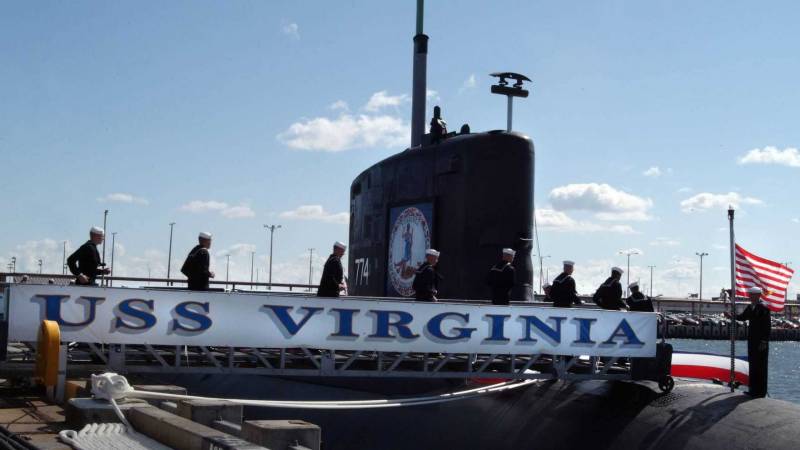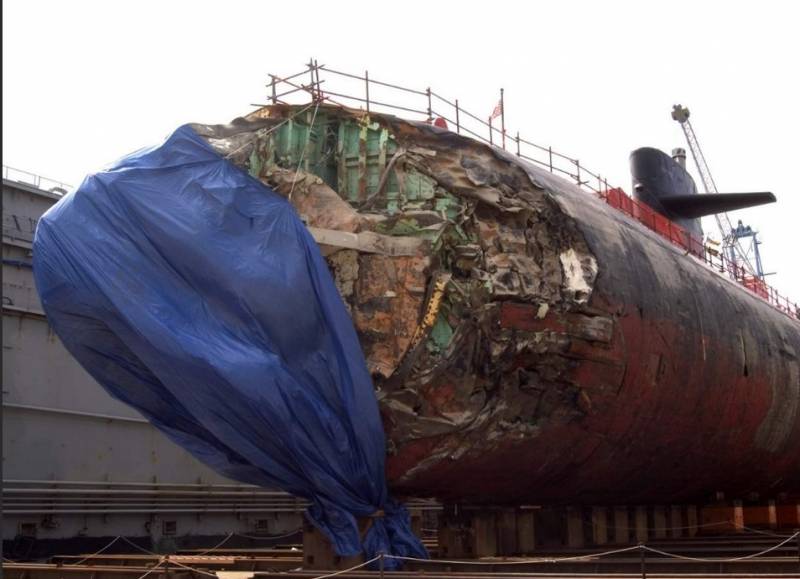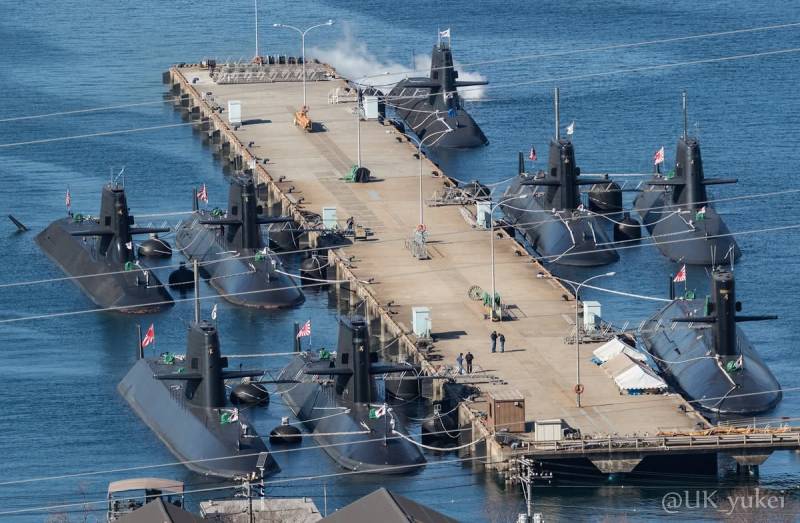Indeed, the news very ambiguous, but excuse me, but when was everything clear and unambiguous? However, the suddenly awakened interest in diesel-electric submarines among American specialized media such as “1945” and “The Drive” is revealed quite simply

Dr. James Holmes in his article issued the following: The US Navy needs diesel-electric submarines now. On the other side of the world, many have made their way, but here’s the catch – Holmes is one of those people who are listened to. Although, of course, he has a reputation …
James Holmes, although a doctor, and even heads the department of naval strategy at the Naval War College, but first of all he is a former officer in the US Navy, he was the last artillery officer of the battleship Missouri and can be said to have entered the history. Yes, 1991, Persian Gulf. Holmes gave the command to fire 406-mm shells, after him no one else did this.

In addition to teaching naval strategy, Holmes writes books. His collaboration with Toshi Yoshihara, Red Star Over the Pacific, was voted Best Book of 2010 by the Atlantic Monthly. And it is recognized not only in the United States, but also in China, which, in fact, was discussed.
That is, the person understands what he is talking about. Some US military analysts believe that Holmes is exaggerating on China and exaggerating the power of the PRC, but everything is not so clear-cut.
The fact is that not so long ago, the US Navy presented Congress with a secret shipbuilding plan, according to which the US will have a navy of 381 ships, not counting ships without a crew, which they would like to have about 150. This is more than 299 ships in service today. , and this will exceed the level of 355 ships provided by US law by 26 ships.
“Hawks” is, of course, happy. Increase fleet for some, a balm for the soul, because they are naval fans, for others – an opportunity to earn money. For such, this is very good news, provided that the US shipbuilding complex can cope with the additional load. In this, by the way, there are certain doubts among many in the United States.

And of course, an indispensable condition is the provision of these programs with money. If Congress raises enough taxpayer money to build, operate and maintain such a fleet, then in theory it looks like nothing. Vigorously and confidently.
Whether legislators will see the matter through is a question. After all, it’s been seven years since they introduced the 355 ship mandate, and the actual number of warships is hovering where it was in 2016. And today, many in the US are already really stressed by the way China’s shipyards are building ships and submarines on their way to the announced PLA fleet of 500 ships.

In general, there are doubts about the capabilities of American shipyards. In addition, one should not discount the power required for the maintenance and overhaul of ships. US Navy officials have announced that of the 49 nuclear attack submarines (SSNs), 20 percent are in maintenance and overhaul at any given time.
In addition, there are ships that are idle waiting for major repairs. As an example – the same “Connecticut”, which collided with something unidentified in the South China Sea.
By the way, the South China Sea – we will return to it, this is, in fact, a separate issue.
In total, if you believe the statistics, then to complete all the tasks in the two oceans, the United States has only 31 boats in combat condition. A lot of? Few? Enough? It all depends on the time when the kneading starts, weapons never even enough. It has been tested many times in practice.
Of course, the United States is working on this, and last year, as part of the publication of the unclassified part of the shipbuilding program, a figure of 66 submarines was announced, but it looks somewhat fantastic. That is, it is necessary to build “only” 17 submarines. Looks, you know…
Hence, information about unmanned underwater vehicles such as “Orca” (XLUUV) does not look like something so supernatural. In theory, a 50-meter unmanned damn thing will serve as a minelayer, and defense manufacturers and the navy will work on adding new missions to the unmanned underwater vehicle capability.

In general, it must be said that the Orca project is a promising development. The US Navy as a whole is trying to implement its plan to distribute combat power among a much larger fleet, and not concentrate it in a few dozen large, expensive, albeit multi-purpose ships like the same aircraft carriers or UDC.
The sinking of a missile cruiser or destroyer, or putting such a ship out of action, immediately reduces the share of the total combat power of the fleet. Accordingly, it requires strengthening anti-surface, anti-submarine and air defense along with anti-missile defense. And this is quite logical, because the loss of one ship (or several) immediately reduces the ability to connect ships in a given region.
Conversely, the dispersal of firepower, sensors, and command and control functions gives stability to formations of ships in a combat situation. The fleet continues to fight despite the loss of individual combat units.
And here we are looking at the South China Sea

We are looking not only at a frankly small water area, but also at a decent number of islands. A rather small number of square kilometers of land and the huge ambitions of some countries.
In general, this water area does not have a single name. The world knows it as the South China Sea, Vietnam calls it the East Sea, and the Philippines the West Philippine Sea. It washes the shores of eight countries in the southeastern part of Asia and is an important strategic place on the world map. It is here that the main world shipping routes pass. For example, 50% of all Indian exports and imports and two-thirds of all oil entering China move through the South China Sea.
Therefore, control over this sea area was an important geopolitical task for the states. But in the South China Sea, a unique situation has developed – in its waters there are two archipelagos that … generally draws!
On the one hand, this is strange, on the other hand, it is justified. There are two archipelagos on which the natives never lived, there were no mountains, lush vegetation, or sources of water. Seriously, just pieces of land scattered (very chaotically) over the surface of the great Pacific Ocean. Coral reefs, atolls, rocks. The area of the largest island was 1,5 square kilometers, the area of the smallest island was 0,08 square kilometers.
130 islands and islets of the Paracel archipelago and 150 islands of the Spratly archipelago. There are no animals, no birds, no people on them, there are no convenient bays for parking either. Therefore, the two archipelagos for a long time remained without the attention of the adjacent states.
But today the Paracels and the Spratlys are such a complex piece of land that the Falklands are nothing compared to them. SIX states claim these territories. China, Vietnam, Philippines, Malaysia, Taiwan and Brunei. The last three active actions are not taken and are only limited to claiming their rights to parts of the archipelago. But China, the Philippines and Vietnam are much more determined.

The race for sovereignty. Familiar? Yes. So China, Vietnam and the Philippines compete to set their flags on the islands, or even several times. Plus the constant debate at the UN and demands to recognize the territories as their own. But China went the farthest: in 1947, he released his atlas, where he took absolutely all the islands with a wide hand, even those on which the flags of other countries fluttered. Modest and tasteful.
Then there were the courts initiated by the Philippines at the UN to recognize the illegal occupation of the PRC of the islands, there was a decision of the international court in 2016, which condemned China’s policy and ruled that the PRC has no “historical right” to the disputed territories in the South China Sea.
And what? And nothing. If you have a fleet of 500 ships, you don’t care. So China is somehow purple on the UN decisions.
Why? It’s simple: oil and gas on the shelf near the same Spratly Islands. It seems like a draw, but … As soon as China begins work on oil exploration and production, Vietnam brings almost its entire navy into the water area, the Philippines begin exercises in the area, Taiwan strengthens its garrison, and Brunei and Malaysia begin to vote in the UN.
China responds by ramping up its military presence, and soon there are so many gun-toting ships in the region that there simply isn’t room for geologists, drillers, and builders in the sea.
In fairness, it should be said that if Vietnam begins exploration work, then everything is repeated exactly the opposite.
A fair question arises: what does diesel-electric submarines, so much needed by the United States, have to do with it?
Answer: what does the nuclear submarine “Connecticut” have to do with it, which has swooped down in … yes, in the South China Sea?

The practice of the presence of US Navy nuclear submarines has shown that the South China Sea is, to put it mildly, a bit crowded for them.
The US Navy, the Marine Corps do not hide the fact that they are working on tactics of action in the Asia-Pacific region, since the PLA Navy is the main headache for American strategists today.
In terms of tactics, everything is simple: it is necessary to deprive the enemy of the advantage in the sky and on the water that surround the islands that make up the first chain of islands in Asia.
If you seal the first chain of islands, and lock the PLA Navy and Air Force together with the Chinese merchant fleet in the near seas, deprive them of the ability to maneuver, and half the task of neutralization will already be solved.
And here the submarine forces come on the scene, which, like no one else, can cope with the task of blockade. This was proven by two World Wars in the performance of German submariners.
A nuclear submarine in the straits between the islands is not a very wise decision. They are too big and not very maneuverable. But the US Navy has no others.
True, the allies have diesel-electric submarines in various blocks of the AUKUS type. There are many nuances here, really. For example, South Korea and Japan will not be US allies in the same military alliance. Japan occupied Korea, the Koreans are not just “not forgotten, not forgiven”, but there is a certain hostility.
The Republic of China, which on Taiwan will also never ally with Japan. And the Philippines. They all got it from the Japanese during the Second World War, BUT: the United States has bilateral defense treaties with all of the above countries.
That is, South Korea, Taiwan, the Philippines will support all US undertakings on the one hand. On the other hand, there will be Japan.
Something like “divide and conquer”, but the implementation of this principle gives about a million soldiers and two (Japanese and South Korean) very decent fleets. Plus, all four countries (except the Philippines) are not very good looking towards China.
So the blockade, patrol service in the conditions of islands and straits is a fairly easy task for diesel submarines. Both the Japan Maritime Self-Defense Force and the Republic of Korea Navy, which use diesel-electric submarines, have long been successful at this.

But the trouble is – will these countries “in which case” start fighting on the front section of the sea front without the United States? The question is rather complicated.
The experience of previous NATO operations shows that yes, the British, Canadians, Germans, even Italians behave very well if the Americans are around. Naturally, in quantities proportional.
As in the same Iraq, where during the first Gulf War the United States fielded 450 people, and, say, France 000. That is, 18 to 000. Well, you understand the analogy.
Without the Americans, the war with China will not work. This can generally be taken as an axiom. And, if someone wants to do something like that with China, then he just needs to be aware of how everything can end before it starts.
Holmes almost openly says that the principle “If you want everything to be good, do everything yourself” is inscribed here in fiery letters, as at the feast of King Belshazzar.
But here, instead of Belshazzar, it could be the Commander-in-Chief of the US Navy.
That is, if the United States wants to take control of the South China Sea with its allies, then they will have to fork out. The sea is not for nuclear submarines and aircraft carriers.
Small and all in the islands. But diesel-electric submarines that will close the straits and straits are serious.
And here the American generally says sedition: if the United States does not have its own (and where should they come from, America has not been building its diesel-electric submarines for a long time) capacities and projects, why not order boats on the side? For example, the same allies of the Japanese.
It can be assumed that, say, Mitsubishi Heavy Industries, which produced the Soryu and today produces the Taigei, which are definitely very good boats, could lay a certain number of ships for the United States.
I don’t even want to talk about the capabilities of another giant, Hyundai Heavy Industries.
Chinese shipbuilding is something, but together Japanese and South Korean shipbuilders will be cooler.
Besides, money!
The Japanese Parliament has allocated $602,3 million for the latest version of the Taigei-class boats, which are equipped with lithium-ion batteries.
Compare that to the whopping $3,45 billion that the next “block” of Virginia-class submarines will cost the US Navy.
That is, five diesel-electric submarines for the price of one nuclear submarine. It’s okay, SSN boats are supposed to cost that much, but…
Filling the above deficit of 17 submarines (in the case of non-nuclear boats) will cost taxpayers about $10,24 billion. This, of course, is much less than the originally laid down price of $58,65 billion for 17 Virginia Block V boats.
This figure should please budget-conscious employees in Congress, on the one hand, and on the other, non-nuclear boats will really enhance the capabilities of AUKUS exactly there, in native Chinese waters.
Under the AUKUS agreement, the United States will provide the Royal Australian Navy with three to five Virginia-class submarines, operating the Australian Navy until Australian shipbuilders can build the infrastructure and experience to build their own. submarines.
It is difficult to say how feasible this is at all, given that the US Navy has a shortage of submarines, and the same Virginias are not very suitable for operation in inland seas.
To keep the US submarine fleet at least up-to-date, not to mention its expansion, not to mention the supply of nuclear submarines to Australia, the US shipbuilding industry, which is already working in a very tough mode, will have to be strained.
So the option of contacting imported manufacturers is not such a stupid idea. This would satisfy the needs of the US Navy, and would allow America to carry out all its programs of dominion over the world.
If you buy boats from the same Japanese, this will be a very serious step in strengthening the anti-Chinese alliance.
In addition, boats would not have to be constantly transferred from the Asia-Pacific region to the United States for repairs and upgrades. Japan is much closer.
The boats would be based near potential battlefields along the first chain of islands, as well as in shipyards capable of servicing and refitting them.
This is beneficial both from a tactical point of view and from a strategic one. Well, it saves money.
If it is really about how to somehow resist the ever-growing PLA Navy and the ambitions of China, really new moves and new solutions are needed. And the creation of a fleet of non-nuclear submarines could be one such move.
Control over the straits in the transit South China Sea is very important. And for this, you can take such steps.
However, I would add some diesel fuel to the very reasonable tactics of Holmes. American submarines based in the Asia-Pacific but built and maintained in Japan is an interesting move.
But I’m afraid that even in this case, China has an equally original answer, which is generally not paid attention to.
We are talking about such a thing that has disappeared from our everyday life as the fishing fleet of China, capable of putting at least a thousand ships “under a mine”.
It’s really scary: at every corner, at every island and in every strait, a fishing seiner will stick around and feel submarines with their sonars, with which they are looking for schools of fish.

The tactic is simple: a trough with sonars and a radio station / satellite channel (which China has no problems with) controls part of the sea area. And there are dozens of such boats.
Hundreds. When a boat is found, they simply give the coordinates, after which the sea aviation and the submariners begin to have a headache and body pain.
But this is also a theory. We will see how it will be in practice. But the fact that China will not be given this sea just like that is clear and understandable. The question is how and what the parties will do in this direction.





